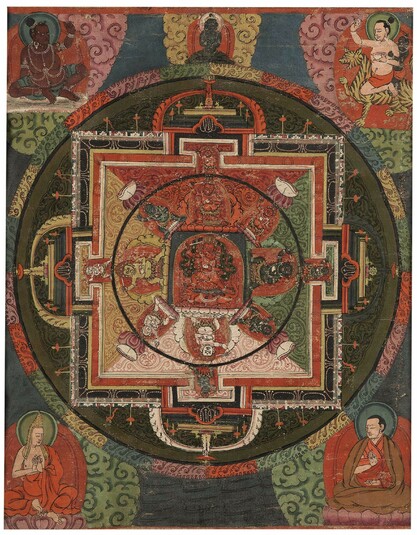
Item: Mandala of Yamari, Rakta (Buddhist Deity) - (Shridara Lineage, 13 Deity)
| Origin Location | Tibet |
|---|---|
| Date Range | 1500 - 1599 |
| Lineages | Buddhist |
| Material | Ground Mineral Pigment on Cotton |
| Collection | Private |
Classification: Deity
Appearance: Wrathful
Gender: Male
Rakta Yamari Five Deity Mandala (Tibetan: shin je she mar po kyil khor lha nga. English: the Red Enemy of Death): a Tantric manifestation of the wisdom bodhisattva Manjushri. The mandala most probably belongs to a set of Vajravali set of compositions numbering twenty-seven or more. (See other paintings from the same set).

Within the center of the two-dimensional circular diagram (mandala) representing the top view of a three-dimensional celestial palace is the wrathful deity Rakta Yamari embracing the consort Vajra Vetali. With one face and two hands the right hand holds aloft a vajra stick ready to strike and the left a skullcup held to the heart; embracing the consort. Very fierce in appearance with the hair flowing upward like fire, large eyes and a gaping mouth, the right leg is bent and the left extended standing above a black corpse and a reclining red buffalo. The consort, Vajra Vetali, stands on the right leg with the left wrapped around the partner. Holding a skullcup in the left hand she exhibits a fierce demeanor. They both wear bone and jewel ornaments, silk garments, a necklace of heads and a lower garment of tiger and leopard skin; completely surrounded by the flames of pristine awareness.
Surrounding the central Yamari in the four main directions - above (west) is red Raga Yamari embracing the consort white Sarasvati. To the right (north) is green Irshya Yamari embracing the consort light green Gauri, below (east) is white Moha Yamari embracing the consort black Carchika, to the left (south) is yellow Matsarya Yamari embracing the consort light yellow Varahi. In each of the four intermediate directions above a pink lotus is an initiation vase tied with a silk ribbon and topped with a skullcup. Surrounding the mandala figures is the geometric form of a celestial palace placed squarely on a double vajra (Sanskrit: visvavajra) with only the prongs appearing on the four sides. The structure is surrounded by a circle of lotus petals and five coloured flames.
At the top left is mahasiddha Virupa. On the right side is Dombi Heruka riding a tiger. At the bottom left is in Indian monastic teacher wearing a yellow hat. On the right side is a Tibetan teacher wearing monastic robes.
Rakta Yamari is a Tantric Buddhist meditational deity believed to be an emanation of the deity and bodhisattva Manjushri. There are two general types of Yamari deities - red (rakta) and black (krishna). The Red (rakta) Yamari has several different traditions - each primarily differentiated by the number of deities represented in the mandala and the associated human lineage teachers. The Krishna and Rakta Yamari figures belong to the New 'Sarma' Tradition of Tibetan Buddhism and are practiced in all of the main schools. Manjushri has a number of popular meditational forms belonging to the Anuttarayoga Classs of Tantric Buddhism which are primarily the Manjuvajra Guhyasamaja, Vajrabhairava, and the two Yamari - red and black. Manjushri also has dozens of peaceful meditation forms originating in the Kriya, Charya and Yoga Tantras.
In the Sarma Schools there are three main forms of Rakta Yamari: (1) the solitary figure Rakta Yamari. The subject of this present painting is known as the (2) Rakta Yamari with Five Deities and lastly the (3) Rakta Yamari with Thirteen Deities of the Shridhara lineage. All of these are found in the 17th chapter of the Rakta Yamari Tantra.
The Main Indian Lineage: Vajradhara, Manjushri Yamari, Jnanadakini, mahasiddha Virupa, Dombi Heruka, Viratipa, Matigarbha, Gambhiramati, Vajrasana Ashokashri, Nishkalangka Devi, Revendra Prabha, Chag Lotsawa Choje Pal (Tibetan), etc. There were many lineages of Rakta Yamari to enter Tibet and most are traced back to Virupa.
Jeff Watt 2-2014
Collection of Tamashige Tibet Collection
Buddhist Deity: Yamari, Rakta (Mandalas)
Painting Set: Vajravali (RMA, Tamashige)
Painting Set: Vajravali (RMA, Tamashige)
Buddhist Deity: Yamari, Rakta (with corpse)
Buddhist Deity: Yamari, Rakta, Main Page
Collection of Tamashige (Mandala Paintings)
